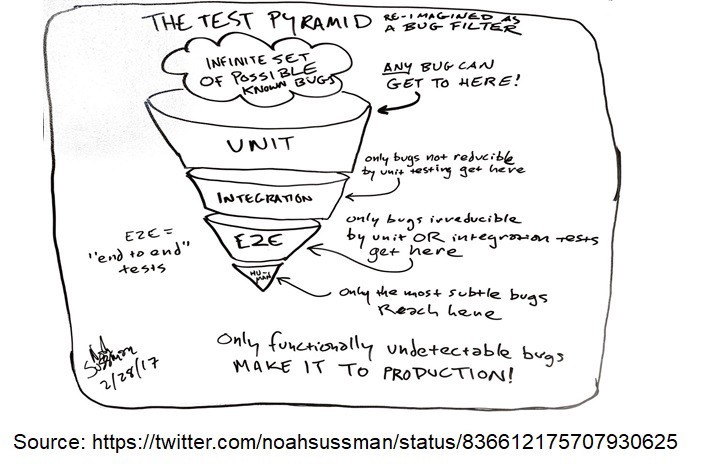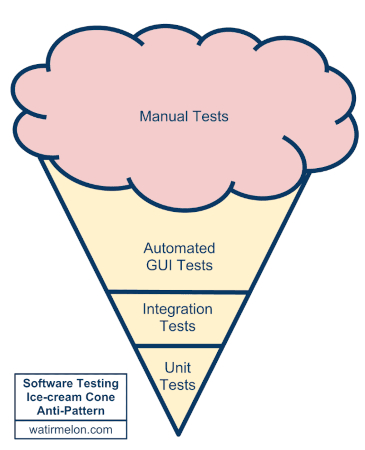Some ideas on software testing
What is quality?
The degree to which a component or system satisfies the stated and implied needs of its various stakeholders. ― ISTQB
“Quality is not an act, it is a habit”. ― Aristotle
“Software never was perfect and won’t get perfect. But is that a license to create garbage? The missing ingredient is our reluctance to quantify quality.” ― Boris Beizer
“Quality means doing it right even when no one is looking” ― Henry Ford
What is testing?
James Bach and Michael Bolton make a distinction between testing and checking.
Testing is the process of evaluating a product by learning about it through experimentation, which includes to some degree: questioning, study, modelling, observation and inference.
A test is an instance of testing.
Checking is the process of making evaluations by applying algorithmic decision rules to specific observations of a product.
A check is an instance of checking.
So, not all testing can be automated!
What is an integration or unit test?
I think that the most confusing thing about testing is the word testing (Feathers, 2016)
We have a problem!
The software development community hasn’t agreed and settled on well defined terms around testing.
Solution
We shouldn’t get too hung up on ambiguous terms, it doesn’t matter if an integration test here doesn’t match a definition at another organisation.
What’s important is that we’re clear about the different types of test that we want to write.
Different types of tests
- Unit tests
- Integration tests
- Component tests
- Integration contract tests
- End-to-end tests
- Exploratory tests
- Security / Pen tests
- Performance tests
- Other non-functional tests, such as testing accessibility, usability, failover and recovery and compatibility.
Unit tests
A unit test exercises the smallest piece of testable software in the application to determine whether it behaves as expected. (Martin Fowler)
- Typically exercises functions, methods and classes.
- They should be short and sweet, ideally the smaller the unit the better as this provides more granular detail on how the code behaves.
- Unit tests should not have any external dependencies, mocks and monkey-patching are for this.
- The idea is to have many smaller tests that execute within a matter of seconds rather than minutes.
- Unit testing enables practices such as Test-driven Development (TDD), where tests are written before the feature code, the feature code is then written to make the tests pass.
Integration tests
Verifies the communication paths and interactions between components to detect interface defects.
- Some define integration testing as testing the entire stack of the application, connected to other applications.
- Others define it as narrowly testing one integration point at a time by replacing separate service and databases with test doubles.
- Service calls to REST APIs can be considered integration tests.
- Integration tests should be black-box and only interact with live instances of the product, rather than the code.
End-to-end tests
Verifies that a system meets external requirements and achieves its goals, testing the entire system, from end to end.
- End-to-end tests cover a user journey or path through a system
- Typically they interact with the system as a user would
- Manipulating a system through a UI can be considered a E2E testing as it requires the full stack to be present.
- End-to-end tests usually run against a system deployed in a environment as close to production as possible.
The Testing Pyramid
In 2009, Mike Cohn published “Succeeding with Agile” and introduced the model of a test automation pyramid.
It has since been widely adopted since the mid 2000’s as the industry-standard guideline for functional test case development.
Mike Wacker from the Google Testing Blog states how Google often suggests a 70/20/10 split: 70% unit tests, 20% integration tests, and 10% end-to-end tests (Wacker, 2015); which demonstrates how most of the testing should happen lower down in unit and integration tests.
Alternative view?
We can also view the test pyramid upside down as a bug filter.
Fowler (2012) states if you get a failure in a high level test; then you have a bug in your functional code and also a missing or incorrect unit test.
We don’t want an ice cream cone!
Alister Scott’s ice-cream cone antipattern occurs, when most of the system is tested by higher layer tests, such as relying on UI tests or manual testing.
Disadvantages
- Costly to run and develop and maintain
- Timely feedback loop as tests take longer to run
- Makes it difficult to make changes and refactor confidently due to few or no unit tests
- Bugs takes longer to diagnose
- Tests are broken by new changes regularly and there can be a reliance on “testing” to fix them
Key points
Tests should catch bugs as close to the root cause as possible and unit tests are the first line of defense.
Unit tests are cheaper to write and maintain and quicker to run, let’s write more of them.
Tests on the upper levels are more expensive to write and maintain and are slower to run, so we want lots of unit tests, some integration tests and a few end-to-end tests.
A risk-based strategy to push testing down the test pyramid is better than having many higher-level tests.
The test pyramid is a guideline and not a rule, the shape of pyramid is less important than the placement of the layers - the sense of “do more at lower levels” is the general thought.
Testing and quality is a team effort!
References
Cohn, M., 2009. Succeeding With Agile. Pearson.
Feathers, M., 2016. Michael Feathers - Characterization Testing. [online] Michaelfeathers.silvrback.com. Available at: https://michaelfeathers.silvrback.com/characterization-testing
Fowler, M., 2012. Test pyramid. [online] martinfowler.com. Available at: https://martinfowler.com/bliki/TestPyramid.html
Fowler, M., 2014. Testing Strategies In A Microservice Architecture. [online] martinfowler.com. Available at: https://martinfowler.com/articles/microservice-testing
Gregory, J. and Crispin, L., 2015. More Agile Testing. Upper Saddle River, N.J: Addison-Wesley.
Vocke, H., 2018. The Practical Test Pyramid. [online] martinfowler.com. Available at: https://martinfowler.com/articles/practical-test-pyramid.html
Wacker, M., 2015. Just Say No To More End-To-End Tests. [online] Google Testing Blog. Available at: https://testing.googleblog.com/2015/04/just-say-no-to-more-end-to-end-tests.html



